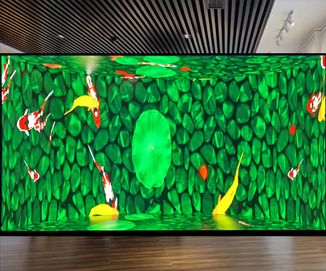Publisher: Supplier of LED Display Time: 2024-04-25 16:31 Views: 1205
LCD screens (liquid crystal displays) and LED screens (light-emitting diode displays) each have their own characteristics and applicable scenarios. We cannot simply say which one is absolutely "good". Choosing which one is better mainly depends on the specific application needs, budget and the requirements for the application. Displays trade-offs in factors such as performance, power consumption, and environmental adaptability. The following is a summary of the main differences between the two compiled by the editor of LCF.
LCD screens use a liquid crystal layer to control the degree of light transmission, while LED screens use light-emitting diodes as backlight sources. Specifically, the LCD screen places a liquid crystal cell in two parallel glass substrates, sets a thin film transistor on the lower glass substrate, sets a color filter on the upper glass substrate, and then changes the liquid crystal molecules through the signal and voltage of the thin film transistor. direction, so that each pixel emits polarized light to achieve the purpose of display. The LED screen is composed of light-emitting diodes made of compounds containing gallium (Ga), arsenic (As), phosphorus (P), nitrogen (N), etc. Its light-emitting principle is to radiate light when electrons and holes combine. visible light to create a light-emitting diode.
1. Advantages of LCD screen
•Color reproduction and fineness: LCD screens usually have better color accuracy, color gradation performance and contrast. Especially high-end LCD panels can present richer color levels and finer image details, which are suitable for color accuracy requirements. Higher applications, such as professional graphic design, photography post-production, medical imaging, etc.
•Visual comfort: Since LCD screens typically have lower blue light output and softer brightness controls, long-term viewing may cause relatively little eye fatigue.
•Cost and energy saving: Compared with LED screens of the same size and level, LCD screens tend to be cheaper, consume less power under the same display effect, and are more energy-saving.
•Stability and lifespan: The liquid crystal material and backlight system of the LCD screen are relatively stable under normal use conditions and have a long service life.

2. Disadvantages of LCD screen
•Viewing angle limitations: Some LCD screens may suffer from color shift or contrast loss at larger viewing angles, especially in older TN panels, but wide viewing angle panels such as IPS and VA have significantly improved this problem. .
•Response time: The response time (pixel switching speed) of the LCD screen may be slightly slower, and there may be slight smearing for high-speed motion pictures, although modern LCD technology has greatly reduced this effect.
•Thickness and weight: Due to the need for a backlight module, LCD screens are usually thicker and heavier than LED screens of the same size, which may not be ideal for mobile devices or installation environments with limited space.
3. Advantages of LED screen
•Brightness and contrast: LED screens, especially those used outdoors, are extremely bright and can be clearly visible even under strong sunlight. The high contrast ratio makes the image more vivid, especially in dark field performance, which is better than most LCD screens.
•Environmental adaptability: LED screens usually have better waterproof and sunscreen properties, are suitable for various outdoor environments, and can withstand large changes in temperature and humidity.
•Seamless splicing: LED screens can achieve seamless splicing, especially suitable for applications that require large-area continuous display such as large billboards and stage backgrounds.
•Plasticity: LED screens can be made into various shapes and sizes, including curved surfaces, special-shaped screens, etc., with high design flexibility.
4. Disadvantages of LED screens
•Close viewing effect: The pixel pitch (pixel pitch) of LED screens is usually larger than that of LCD screens, and it may appear grainy when viewed at close range, making it unsuitable for applications that require fine display or close interaction.
•Color uniformity and consistency: LED screens may have certain color uniformity problems. Especially on large screens, color and brightness may be inconsistent, which requires fine correction.
•Energy consumption and heat: High-brightness LED screens consume relatively high energy and generate more heat, and may require additional heat dissipation measures.
•Cost: For the same display area, especially high-resolution small-pitch LED screens, the cost is usually higher than LCD screens.
To sum up, if you value color reproduction, fineness, comfort for long-term viewing, and cost-effectiveness, LCD screens may be a better choice, especially suitable for indoor office, home entertainment, medical, education and other scenarios. And if you need to create high-brightness, seamless splicing, and highly visually impactful displays in outdoor, stage, large-scale advertising displays, etc., or have special needs for screen shape design, LED screens will be more suitable. choose. When making actual decisions, factors such as the specific use environment, budget, and intended use should be considered comprehensively.
The above is a summary of relevant knowledge about which LCD screen or LED screen is better compiled by the editor of LCF. I hope it will be helpful to you. At the same time, you are welcome to add or correct. Lianchengfa (LCF) is a national-level professional and new "little giant" enterprise, an LED display application and solution provider integrating "hardware + software + content + interaction". If you want to buy an LED display, you can also directly contact LCF LED display manufacturer, a big brand and trustworthy!